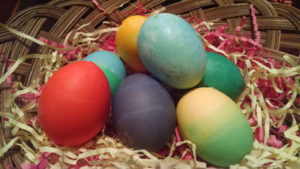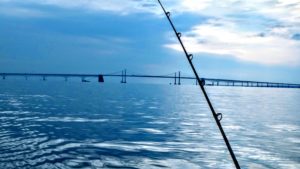Easter is almost here! What a fun time coloring and decorating hard-boiled eggs with friends and family.

But have you ever wondered about how to safely handle your hard-boiled eggs? Below are some of the top questions I get asked during the ServSafe Manager Training.
How can eggs make you sick?
The pathogen of concern is Salmonella. Salmonella (nontyphoidal) is the number 2 pathogen that causes foodborne illness in the US and the number 1 that causes hospitalization and death. The CDC estimates over 1 million illnesses a year. 79,000 of those come from of Salmonella Enteritidis which comes directly from improperly handled eggs. People that are infected will usually become ill 12-72 hours after consuming the bacteria. Symptoms include diarrhea, fever, abdominal cramps and vomiting. People with weakened immune systems are at a greater risk.
How does Salmonella affect a regular shell egg?
The bacteria is carried in the fecal matter of the hen. It can be introduced to the egg shell when the hen is laying the egg. The bacteria can enter through the porous shell of the egg. The Salmonella Enteritidis can also be introduced to the egg before the shell is formed in the intestinal track of the hen.
Why are raw eggs in some countries not refrigerated?
The production process is different in the US from European countries, because of this the USDA requires producers to wash and sanitize the egg before selling. This creates an environment where air and bacteria can more easily pass through the shell. Therefore, temperature control is required.
Do hard-boiled eggs need to be refrigerated?
The CDC, USDA, Egg Board and FDA consumer guidelines all agree after an egg is hard-boiled the surface even more porous. The recommendation is that eggs be refrigerated at 40°F or below for no more than 7 days. The only source of information that is different is the FDA food code for retail food establishments. Raw shell eggs can be stored at 45°F or below. Water cooled eggs must be stored at 41°F or below and as stated in Annex 3 Public Health Reason / Administrative guidelines 3-501.14, air cooled eggs are no longer a TCS food.
“Hard-boiled eggs with shell intact may be cooled in ambient air and are not considered to be a time/temperature control for safety food after cooling. Hard-boiled eggs may be cooled in drinking water but are considered to be a time/temperature control for safety food after cooling because pathogens, which may be present in the water, may pass through the egg shell during cooling”
Should you eat eggs that have been used for hiding?
Yes and No. As long as the egg has not been left at room temperature for more than 2 hours and the egg is washed off before placing back in refrigeration you should be safe. However, it would be safer to use other items like plastic reusable eggs for hiding.
Additional Resources:
https://www.fda.gov/downloads/Food/GuidanceRegulation/RetailFoodProtection/FoodCode/UCM595140.pdf

 Raw sewage is flowing into our streams and rivers and eventually to the Chesapeake Bay. Where is this sewage coming from? A key source is an antiquated storm water and sewage system for Baltimore City. In 2002 the Maryland Department of the Environment (MDE) sued Baltimore City and an original consent degree to correct overflow of raw sewage was filed. There was a 2016 deadline for Baltimore City to correct existing problems. Although some progress was made, the deadline passed and there were still sever deficiencies. A modified decree was approved October 6, 2017 that extended the time allowed to correct problems. It is broken down in two Phases. First phase must be completed by 2021 and second phase by 2030.
Raw sewage is flowing into our streams and rivers and eventually to the Chesapeake Bay. Where is this sewage coming from? A key source is an antiquated storm water and sewage system for Baltimore City. In 2002 the Maryland Department of the Environment (MDE) sued Baltimore City and an original consent degree to correct overflow of raw sewage was filed. There was a 2016 deadline for Baltimore City to correct existing problems. Although some progress was made, the deadline passed and there were still sever deficiencies. A modified decree was approved October 6, 2017 that extended the time allowed to correct problems. It is broken down in two Phases. First phase must be completed by 2021 and second phase by 2030.